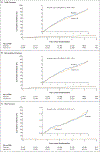Supplemental Vitamin D and Incident Fractures in Midlife and Older Adults
- PMID: 35939577
- PMCID: PMC9716639
- DOI: 10.1056/NEJMoa2202106
Supplemental Vitamin D and Incident Fractures in Midlife and Older Adults
Abstract
Background: Vitamin D supplements are widely recommended for bone health in the general population, but data on whether they prevent fractures have been inconsistent.
Methods: In an ancillary study of the Vitamin D and Omega-3 Trial (VITAL), we tested whether supplemental vitamin D3 would result in a lower risk of fractures than placebo. VITAL was a two-by-two factorial, randomized, controlled trial that investigated whether supplemental vitamin D3 (2000 IU per day), n-3 fatty acids (1 g per day), or both would prevent cancer and cardiovascular disease in men 50 years of age or older and women 55 years of age or older in the United States. Participants were not recruited on the basis of vitamin D deficiency, low bone mass, or osteoporosis. Incident fractures were reported by participants on annual questionnaires and adjudicated by centralized medical-record review. The primary end points were incident total, nonvertebral, and hip fractures. Proportional-hazards models were used to estimate the treatment effect in intention-to-treat analyses.
Results: Among 25,871 participants (50.6% women [13,085 of 25,871] and 20.2% Black [5106 of 25,304]), we confirmed 1991 incident fractures in 1551 participants over a median follow-up of 5.3 years. Supplemental vitamin D3, as compared with placebo, did not have a significant effect on total fractures (which occurred in 769 of 12,927 participants in the vitamin D group and in 782 of 12,944 participants in the placebo group; hazard ratio, 0.98; 95% confidence interval [CI], 0.89 to 1.08; P = 0.70), nonvertebral fractures (hazard ratio, 0.97; 95% CI, 0.87 to 1.07; P = 0.50), or hip fractures (hazard ratio, 1.01; 95% CI, 0.70 to 1.47; P = 0.96). There was no modification of the treatment effect according to baseline characteristics, including age, sex, race or ethnic group, body-mass index, or serum 25-hydroxyvitamin D levels. There were no substantial between-group differences in adverse events as assessed in the parent trial.
Conclusions: Vitamin D3 supplementation did not result in a significantly lower risk of fractures than placebo among generally healthy midlife and older adults who were not selected for vitamin D deficiency, low bone mass, or osteoporosis. (Funded by the National Institute of Arthritis and Musculoskeletal and Skin Diseases; VITAL ClinicalTrials.gov number, NCT01704859.).
Copyright © 2022 Massachusetts Medical Society.
Figures


Comment in
-
VITAL Findings - A Decisive Verdict on Vitamin D Supplementation.N Engl J Med. 2022 Jul 28;387(4):368-370. doi: 10.1056/NEJMe2205993. N Engl J Med. 2022. PMID: 35939583 No abstract available.
-
Vitamin D and Incident Fractures.N Engl J Med. 2022 Oct 27;387(17):1625. doi: 10.1056/NEJMc2211434. N Engl J Med. 2022. PMID: 36300982 No abstract available.
-
Vitamin D and Incident Fractures.N Engl J Med. 2022 Oct 27;387(17):1625. doi: 10.1056/NEJMc2211434. N Engl J Med. 2022. PMID: 36300983 No abstract available.
-
Vitamin D and Incident Fractures.N Engl J Med. 2022 Oct 27;387(17):1625-1626. doi: 10.1056/NEJMc2211434. N Engl J Med. 2022. PMID: 36300984 No abstract available.
-
Vitamin D and Incident Fractures.N Engl J Med. 2022 Oct 27;387(17):1626. doi: 10.1056/NEJMc2211434. N Engl J Med. 2022. PMID: 36300985 No abstract available.
-
In generally healthy adults, supplemental vitamin D3 did not reduce fractures vs. placebo at 5 y.Ann Intern Med. 2022 Dec;175(12):JC134. doi: 10.7326/J22-0099. Epub 2022 Dec 6. Ann Intern Med. 2022. PMID: 36469925
-
Evaluating benefit from vitamin D supplementation: defining the area for treatment.Osteoporos Int. 2023 Sep;34(9):1531-1533. doi: 10.1007/s00198-023-06802-x. Epub 2023 May 27. Osteoporos Int. 2023. PMID: 37243726 No abstract available.
References
-
- Office of the Surgeon General. Bone health and osteoporosis: a report of the Surgeon General. Rockville, MD: Department of Health and Human Services, 2004. - PubMed
Publication types
MeSH terms
Substances
Associated data
Grants and funding
- R01CA138962/CA/NCI NIH HHS/United States
- R01 AT011729/AT/NCCIH NIH HHS/United States
- R01 CA138962/CA/NCI NIH HHS/United States
- R01AR060574/AR/NIAMS NIH HHS/United States
- R01AR059775/AR/NIAMS NIH HHS/United States
- R01 AR059775/AR/NIAMS NIH HHS/United States
- R01AR070854/AR/NIAMS NIH HHS/United States
- R01AT011729/AT/NCCIH NIH HHS/United States
- R01 AR060574/AR/NIAMS NIH HHS/United States
- U01 CA138962/CA/NCI NIH HHS/United States
- R01 AG071611/AG/NIA NIH HHS/United States
- R01 AR070854/AR/NIAMS NIH HHS/United States
- U01CA138962/CA/NCI NIH HHS/United States
LinkOut - more resources
Full Text Sources
Other Literature Sources
Medical
